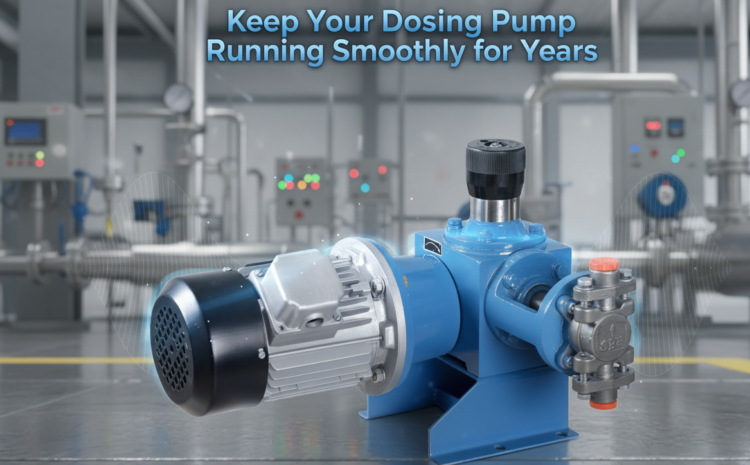
Keep Your Dosing Pump Running Smoothly for Years
Dosing/Metering Pumps and Dosing Systems are integral to a wide range of industries, including water treatment, chemical processing, the oil sector, food and beverage manufacturing, and pharmaceuticals and many more. Designed for precision, reliability, and durability, these pumps ensure accurate chemical dosing and consistent process performance.
However, like all vital equipment, the lifespan of a dosing pump largely depends on proper care and maintenance. By following best practices, you can keep your pump running efficiently for years while minimizing downtime and costly repairs.
Here are the essential guidelines to maximize your dosing pump’s performance and longevity:
Choose the Right Pump for Your Application
Selecting the right pump from the outset is crucial for long-term performance. Consider these factors:
- Flow rate and pressure requirements: Avoid underloading or overloading your pump, as both can accelerate wear and cause damage.
- Chemical compatibility: Ensure pump materials (PTFE, stainless steel, PVC, PP, etc.) match the chemicals you are dosing.
- Operating conditions: Account for fluid temperature, viscosity, and particulate content.
Choosing the correct pump upfront helps prevent premature failures and reduces maintenance costs over time.
Follow Manufacturer Guidelines
Manufacturers provide detailed instructions to ensure safe and efficient operation. Key points include:
- Proper installation: Correct mounting, alignment, and electrical connections.
- Operating within recommended parameters: Maintain the advised dosing rates and pressures.
- Use approved lubricants and consumables: This protects internal components and maintains performance.
Ignoring these instructions can reduce pump efficiency, increase wear, and may even void warranties.
Regular Maintenance and Inspection
Routine inspections are essential to extend the life of your dosing pump:
- Diaphragm and seal checks: Look for wear, cracks, or leaks.
- Valve and tubing inspection: Replace clogged or damaged parts immediately.
- Lubrication: Follow the recommended schedule to prevent friction and mechanical damage.
- Cleaning: Flush pumps regularly to remove chemical deposits.
Maintaining a logbook to track maintenance activities helps identify recurring issues early.
Maintain Clean and Stable Operating Conditions
Environmental and operational conditions can significantly impact pump performance:
- Filter fluids: Remove solids or contaminants before they reach the pump.
- Avoid dry running: Always prime the pump before use.
- Protect against pressure spikes: Sudden changes can damage valves and diaphragms.
- Proper storage: Keep pumps and chemicals in controlled environments to prevent corrosion and chemical degradation.
Clean and stable conditions reduce the risk of wear and costly breakdowns.
Use Correct Operating Techniques
How you operate your dosing pump matters:
- Gradual start-up and shutdown: Reduces stress on diaphragms and seals.
- Adjust flow rates gradually: Avoid sudden changes that may cause damage.
- Monitor system pressure: Prevent overpressure and cavitation.
Even small operational adjustments can significantly reduce wear and tear over time.
Invest in Quality Spare Parts
Using genuine or high-quality replacement parts is vital for pump reliability:
- Non-standard parts can fail prematurely, causing unexpected downtime.
- Maintain a stock of key components like diaphragms, valves, and tubing.
- Proactive replacement: Replace worn parts before total failure occurs.
Quality spare parts help maintain consistent pump performance and reduce long-term costs.
Monitor Performance with Technology
Modern dosing pumps often include digital controls and monitoring systems:
- Track dosing accuracy and flow rate to detect deviations early.
- Set alarms for unusual pressure or flow changes.
- Use data logs to anticipate maintenance needs and prevent unplanned downtime.
A proactive monitoring approach ensures small issues don’t escalate into costly repairs.
Troubleshooting Common Issues
Understanding the common causes of pump failures can save time and extend equipment life:
- Leaking diaphragm: Often caused by chemical incompatibility, overpressure, or worn seals.
- Inconsistent dosing: Could be due to air in the lines, worn valves, or clogged tubing.
- Excessive noise or vibration: May indicate misalignment, cavitation, or loose components.
Regular monitoring and timely corrective action ensure smooth and reliable operation.
A dosing pump is a precision instrument that deserves careful attention. Choosing the right pump, following manufacturer guidelines, performing routine maintenance, maintaining optimal conditions, and using the correct operating techniques are all critical steps to keep your pump running efficiently for years.
Investing time in proactive care not only extends the life of your equipment but also ensures consistent performance and reduces the risk of costly downtime. By implementing these best practices, your dosing system will continue delivering precise, reliable results for your industry applications.
